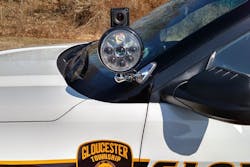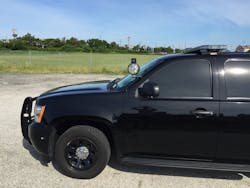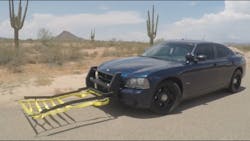Upgrade the Patrol Car With Today’s Technologies
Officers like new toys. They also like toys that have been tested and proven reliable. Toys which are tried and true, innovative and exciting. What they like even more is when these toys are a part of their daily work lives. And the market is flooded with them. Just go to any law enforcement conference or pick up any journal. Type “patrol vehicle accessories” into any search engine and pages of products will pop up. Images for shopping highlighted. There appears to be an endless selection of things to bling out a patrol car. But regardless of the product, when it exists for an officer’s tool belt the most important aspect has to be safety. With officers spending so much time in their vehicle, it’s essential that the accessories meet this need first. There are a number of older and newer products that not only meet this need but also the need for ‘toys’.
Something old: In-car video surveillance
Not new, in fact many decades old, in-car video surveillance has continued to be an accessory that decreases liability and increases officer safety. First rolled out in the late 1960s by the Connecticut State Police, the system used to consist of a video camera on a small tripod which filled the entire passenger seat while the back seat was loaded with the recorder and cables. It was large and cumbersome, but it was also a game changer for law enforcement. Fast forward to the 1980s and in-car video began to be a household name spurred on by Mothers Against Drunk Driving (MADD). By 2000, the National Institute of Justice, Office of Community Oriented Policing Services (COPS) supported agencies by providing funds to purchase systems. By 2003, close to $21 million had already been awarded. To date, close to three-fourths of the agencies within the U.S. have in-car video. But what about the new push for body-worn cameras?
In-car video provides a great third person perspective, explains Brian Kirkham, VP of marketing, WatchGuard Video. “A lot of activity happens right outside the car. Capturing all that, the video and the audio is what in-car systems are doing for you.” Body-worn, on the other hand captures the first person, up-close and personal perspective. “The ideal thing,” he explains, “is to tie those two systems together. We have an integrated and synced in-car and body-worn so [an officer gets] a first person and third person look. That gives you more of the overall look at the incident.” Integration is a new and important aspect and one that agencies have been seeking for some time. “Body-worn camera is a very helpful tool,” Kirkham says. “But it is not yet a replacement for an in-car system. They do things in totally different ways.” WatchGuard offers this integration, as well as advanced features with the company’s 4RE HD Panoramic in-car system. The panoramic camera doubles the field of vision at the same time offering dual recording without additional storage. The Record-After-the-Fact (RATF) feature allows officers to go back in time even if the record button wasn’t pushed due to continuous background recording. “The panoramic camera itself gives you the view from pillar to pillar,” says Kirkham. “If anything happens outside of a normal front of the car view, this is going to capture it.”
Another growing technology that increases officer safety is the automated license plate reader (ALPR). “The addition of ALPR technology to a city’s crime prevention strategy not only yields the benefits of identifying and/or capturing suspects, but accompanying ALPR software provides innovations in predictive policing that help enforcement agencies stop crime before it even begins,” says Keith Yahn, U.S. general manager for NDI Recognition Systems. “Every day, the use of ALPR technology is finding new purposes. It still identifies stolen vehicles and uninsured motorists, but now it can be used to help locate kidnapped children, ticket vehicles for failing to stop for pedestrians, monitor drug traffickers and recognize organized crime hotspots.”
Something newer: Spotlight mounted thermal imaging
An equally exciting vehicle accessory with safety at its heart is the NOPTIC thermal camera. On the market for just over nine years, it’s still a wish-list item for many officers. Unlike hand-held thermal cameras, the NOPTIC mounts on the vehicle’s spotlight and is controlled by the officer from inside. Always on, the system works in complete darkness in temperatures from 176F to -40F and is designed to work with a Windows-based MDT, while at the same time, compatible with a small video screen (USB and RCA). “If an officer doesn’t have a computer, it’s still compatible,” explains Mike Martin, national master distributor, NOPTIC. The benefits other than being cool? “Officer safety and situational awareness,” he says. “It can give an officer the ability to see in the dark.” The ability to be reactive and proactive. “When you’re responding to a call, for example a burglary in progress,” says Martin, “what if the officer didn’t use the spotlight to search? The spotlight tells the bad guy the cops are here. The bad guy will think that the officer doesn’t know they’re there because the lights are off.” Martin also used the example of police ambushes. “What if a police officer, especially out in a rural area, had the ability to see if anyone is hiding? This is where the advantage is.” At the same time, it’s proactive in regards to general patrolling. “It gives an officer the ability to see where he couldn’t see before,” says Martin. “The ability to see in the dark safely.”
And in regards to safety, NOPTIC is outside the vehicle while the officer remains inside. “It gives the officer visual intelligence,” says Martin. “This is not designed to replace your handheld. You can’t take it off the car. It’s right here, right now.” Martin likes to ask law enforcement leaders to think back to when they were on patrol. “To that incident when you wish you had this back then. Why not give that to your officers today? Every officer out there has had an incident where they say, I wish I could see.” When officers can see the bad guy but the bad guy can’t see them, it’s win-win.
Something newest: Mobile vehicle arresting device
If even a decade seems antiquated in the realm of vehicle accessories, there’s a product that had its first operational units set to ship out in late January 2018. The Grappler is an accessory that extends from a police vehicle bumper, throws a net around the tire of an eluding vehicle and stops it. The idea for the device came to Leonard Stock, manager, Stock Enterprises LLC after watching police chases on TV. “I was watching these people evade capture for mile after mile,” he explains. He then went to sleep and the idea just came to him. “It’s the first mobile vehicle arresting device that I know of,” Stock says. “The current methods of stopping a vehicle are getting in front of a vehicle to deploy tire spikes or to do a pit maneuver. Our device allows an officer to stay behind the vehicle 100 percent of the time.”
Stopping the vehicle within seconds, the Grappler increases officer and citizen safety. “If you watch some of the chases where they are able to deploy tire spikes, they can still travel for miles,” explains Stock. “Same with the pit maneuver. Sometimes it’s successful right away but sometimes the suspect can continue to travel. As soon as the net goes over the tire and the officer begins to apply the brakes the chase is over within 10 to 15 seconds.” The company website has a video showing a Dodge Charger stopping a Ford F350. “It’s not going to be used for every chase,” states Stock. “The road surface has to be somewhat smooth. An officer needs to be trained for when it’s going to be effective and safe.” As far as cost—it’s a bit more expensive than remote control spikes but less expensive than the GPS trackers.
What about agencies with no pursuit policies? “Assuming this is successful, officers are using it and it proves to be safer I can see the no pursuit policy agencies maybe taking a look at it.”
Stock believes the Grappler is a whole new category of vehicle accessory. “There’s a category of tracking a suspect vehicle and many methods of deflating tires, but this is a vehicle arresting device that can positively stop a vehicle.” About a year ago, a large agency in the U.S. ordered some evaluation units before they were complete, Stock says. “They were operational but not ready for the field.” Now units will be going out to a European military and an agency in Colorado that had a special design produced for a specific vehicle. Fully disguisable and flexible in function, the Grappler will be exciting to watch once it hits the streets.
Whether innovative and upgraded from decades past, or brand spanking new, vehicle accessories continue to allow officers to do their jobs better and more efficiently, lower liability and increase officer safety. Those wearing the badge and those working in R&D will keep dreaming big about what they would like to see out in the field in the future. Due to this, agencies might need to get a bigger toolbox to fit all the new toys.
About the Author:
Michelle Perin has been a freelance writer since 2000. In December 2010, she earned her Master’s degree in Criminology and Criminal Justice from Indiana State University.

Michelle Perin
Michelle Perin has been a freelance writer since 2000. In December 2010, she earned her Master’s degree in Criminology and Criminal Justice from Indiana State University.





